As a longtime kayaking enthusiast, I’m always on the lookout for ways to enjoy the great outdoors and get the most out of my kayaking adventures. When I first discovered inflatable kayaks, I was intrigued by their portability and convenience, especially when compared to their hardshell counterparts. However, there was one question that I, like many others, couldn’t seem to shake off: How long do inflatable kayaks last?
To answer this crucial question, I embarked on a quest, exploring the world of inflatable kayaks while uncovering the factors that contribute to their lifespan. And now, I’m here to share my findings, helping you make an informed decision on whether an inflatable kayak is the right choice for you. So, join me as we dive into the world of inflatable kayaks, examining their history, material composition, renowned brands, and most importantly, understanding how long these remarkable vessels can provide you with countless hours of fun on the water.
Contents
Contents
Welcome To The World Of Inflatable Kayaks
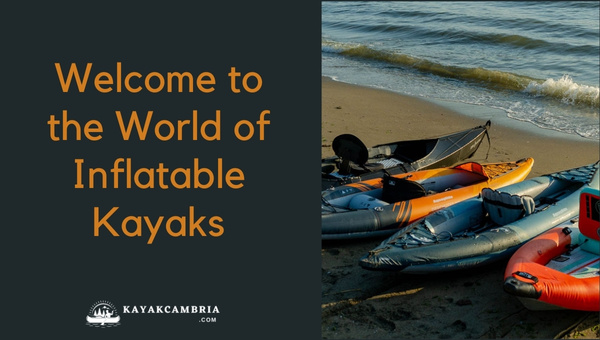
If you’re new to the exciting sport of kayaking, it’s essential to understand what sets inflatable kayaks apart from their hardshell counterparts. In this section, we’ll explore the development of inflatable kayaks and some of the key reasons why they have become a popular choice among outdoors enthusiasts.
Brief History Of Inflatable Kayaks
Inflatable kayaks can be traced back to the early 20th century when they were first used by military personnel for stealthy maneuvers and rescue missions. However, it wasn’t until the 1960s and 1970s, with the advancement of materials and technology, that inflatable kayaks began to gain popularity among recreational users. Today, they have evolved into a diverse range of models for different skill levels and purposes, such as touring, whitewater, and fishing.
Advantages Of Inflatable Kayaks Over Hardshell Kayaks
1. Portability
One of the main reasons inflatable kayaks have been gaining in popularity is their unmatched portability. They are lightweight and easy to deflate, allowing them to be folded down to a compact size. This makes them an excellent choice for those with limited storage space or those who frequently transport their kayak to different locations.
2. Accessibility
Inflatable kayaks have a lower entry barrier than hardshell kayaks, as they are generally more affordable. This makes them an attractive option for beginners who are looking to test the waters before committing to a more expensive purchase.
3. Stability
Contrary to popular belief, inflatable kayaks tend to be quite stable due to their wider base and buoyancy. This can be an advantage for new kayakers learning to balance and maneuver their boats.
Types Of Materials Used In Inflatable Kayaks
Inflatable kayaks are typically made from one of three primary materials: PVC, Hypalon, or Nitrylon. Each material offers its own unique set of benefits and drawbacks.
PVC (polyvinyl chloride)
PVC is a popular and affordable choice for inflatable kayaks. It is lightweight and resistant to UV damage, which makes it ideal for casual kayaking trips. However, PVC is not as durable as some of the higher-end materials and is prone to wear over time, particularly with exposure to harsh chemicals or extreme temperatures.
Hypalon
Hypalon is a more durable and heavy-duty material than PVC, making it a top choice for use in higher-end inflatable kayaks. It is highly resistant to UV rays, abrasion, and chemical damage. The downside is that Hypalon tends to be more expensive than PVC.
Nitrylon
Nitrylon is a newer material that offers a blend of durability, puncture resistance, and environmental friendliness. Although it is heavier than PVC, Nitrylon is more resistant to wear and tear and is commonly used in kayaks designed for rough waters and rugged use.
By understanding the advantages of inflatable kayaks and the materials used to construct them, you can make an informed decision about whether an inflatable kayak will suit your needs and last for years to come.
Factors That Determine The Lifespan Of Your Inflatable Kayak
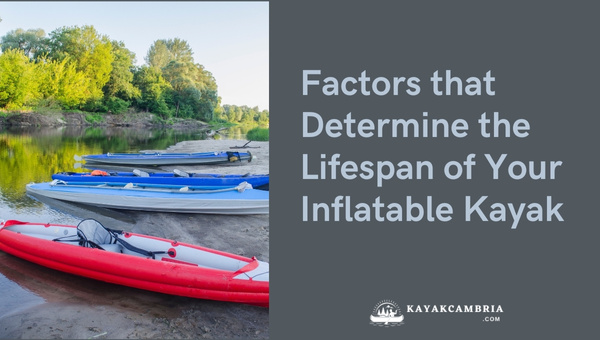
When considering the lifespan of an inflatable kayak, it’s important to recognize that a multitude of factors contribute to its overall longevity. Let’s delve into the key determinants that impact an inflatable kayak’s lifespan.
Material And Construction
Inflatable kayaks are usually crafted from three primary materials: PVC (Polyvinyl Chloride), Hypalon, and Nitrylon. Each material presents its own set of advantages and disadvantages. For example, PVC is affordable and lightweight but less resistant to UV damage and abrasion in comparison to Hypalon and Nitrylon. Hypalon is notable for its durability and resistance to environmental factors, while Nitrylon offers a puncture-resistant and eco-friendly option. The material and construction quality directly affects the kayak’s durability and lifespan.
Proper Care And Maintenance
How well you take care of your inflatable kayak plays a significant role in extending its life. Proper care includes but is not limited to, avoiding over-inflation, ensuring the kayak is cleaned and dried thoroughly after each use, and following proper storage guidelines (e.g., storing it indoors, away from direct sunlight, moisture, and extreme temperatures).
Puncture And Repair
While inflatable kayaks are built with puncture resistance in mind, damage can still occur. The quality of repairs and the extent to which the structural integrity of the kayak is maintained will influence how long the kayak lasts. A well-repaired kayak using appropriate patch material and adhesive can continue to provide a safe and enjoyable paddling experience for years to come, while poor repairs might lead to further complications.
Usage Frequency And The Environment
Finally, the frequency of use and the environment in which you’ll be paddling your kayak greatly impact its longevity. For example, if you’re using your kayak in a calm, flat water, it will likely experience less wear and tear as compared to those used in rough, whitewater environments. Additionally, prolonged exposure to saltwater can cause corrosion and degrade the material over time, hence why it’s crucial to rinse your kayak with fresh water after each use in saltwater conditions. Regularly assessing the environment and choosing a kayak explicitly designed for your intended use will help extend its lifespan.
Products And Brands With Impressive Durability
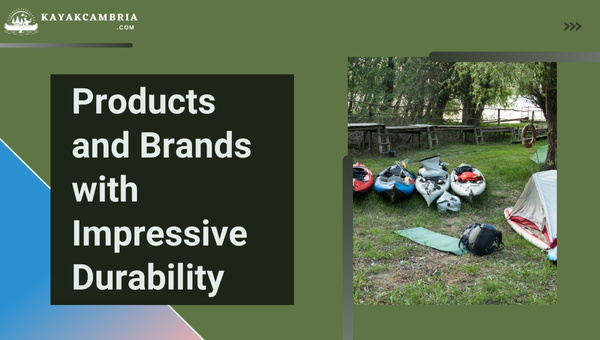
As someone who’s deeply invested in the world of kayaking, I always advocate for choosing high-quality brands that promise durability and longevity. Over the years, I’ve noticed a few brands that stand out from the rest. Let’s dive into some of the most durable and long-lasting inflatable kayaks currently available in the market.
1. Sea Eagle
Long-lasting and reliable kayaks developed through years of experience
With over 50 years of experience in the water sports industry, Sea Eagle has become synonymous with long-lasting and reliable kayaks. Their inflatable kayaks are made from 1000 denier reinforced PVC material, ensuring durability and puncture resistance. Sea Eagle also offers a generous 3-year warranty, giving buyers confidence in their investment.
2. Advanced Elements
Innovative designs combined with rugged and tough materials
Known for their advanced design and construction, Advanced Elements inflatable kayaks are perfect for those who need a highly durable kayak. Utilizing a combination of PVC tarpaulin material and drop-stitch construction, these kayaks can withstand harsh environments while maintaining performance. Advanced Elements offers a one-year warranty to support its products.
3. Intex
Affordable options without compromising on quality or durability
Intex is a great choice for budget-conscious buyers who don’t want to compromise on quality and durability. Their kayaks are constructed from puncture-resistant, 30-gauge K80 PVC material, ensuring a long lifespan. Intex also provides a 90-day warranty, which indicates their confidence in product quality.
4. Aquaglide
Impressive dependability and well-built inflatable kayaks
While still fairly new to the inflatable kayak scene, Aquaglide has quickly made its mark with its rugged and dependable kayaks. Constructed from high-quality Duratex material with a UV-resistant coating, these kayaks resist damage from sun exposure. Aquaglide offers a one-year warranty on their kayaks, demonstrating their commitment to durability.
When looking for an inflatable kayak that offers impressive durability, consider exploring one of these top-notch brands. Of course, always remember that even the best kayak brands require proper care and maintenance to ensure a long life.
Tips On Extending The Life Of Your Inflatable Kayak
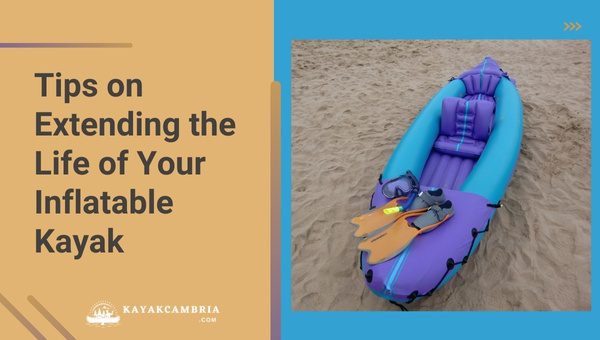
Owning an inflatable kayak means taking responsibility for its care to ensure that it will last for many years. Here are some helpful tips on how to extend the life of your inflatable kayak:
1. Regular Inspections and Maintenance
Inspect your inflatable kayak periodically for signs of wear and tear, especially before and after each kayaking trip, to catch potential issues early on and address them promptly.
2. Proper Storage to Protect from the Sun, Moisture, and Dirt
When not in use, store your inflatable kayak in a cool, dry place, preferably indoors. Avoid direct sunlight as UV rays can cause the material to degrade over time. Make sure that your kayak is clean and completely dry before storing it.
3. Ensuring Proper Inflation Levels Using a Reliable Pump
Using a quality air pump with an accurate pressure gauge is crucial for obtaining the right inflation level for your inflatable kayak. Overinflation or underinflation can cause your kayak to perform poorly and may lead to damage. Inflate the kayak to the manufacturer’s recommended PSI for optimal performance.
4. Invest in a High-Quality Carry Bag with Protection Against Abrasion and Punctures
A sturdy carry bag with padded shoulder straps and reinforced, puncture-resistant materials can protect your inflatable kayak while transporting or storing it. Make sure the carry bag fits your kayak well and can keep it secure and free from damage.
5. Use The Appropriate Kayak For the Intended Use
Always use your inflatable kayak for the purpose it was designed for. For example, if your kayak is meant for flatwater, using it in swift currents or whitewater conditions may lead to damage. Choosing the proper kayak for your intended paddling environment will not only improve your experience but also prolong the life of your inflatable kayak.
By following these tips, you’ll be able to enjoy your inflatable kayak for many fun-filled adventures to come. With proper care and maintenance, your kayak can last for years and become a great companion in your quest for outdoor thrills.
Understanding The Warranty And What It Covers

Before we dive into the warranty aspect, it is essential to understand that not all inflatable kayaks are created equal. Some manufacturers offer a more comprehensive warranty than others, reflecting their confidence in the quality of their products. Therefore, when choosing an inflatable kayak, spend a moment understanding the warranty and what it covers.
Length And Coverage Of The Warranty From Various Manufacturers
Different manufacturers offer varying warranty periods for their inflatable kayaks. For instance, some high-end brands like Sea Eagle and Advanced Elements provide a 3-year warranty, whereas more budget-friendly options like Intex offer a 90-day limited warranty. It’s crucial to go through the warranty card and examine the coverage provided by the manufacturer.
Identifying What Damages Or Issues Are Covered Under Warranty
The warranty conditions generally cover any manufacturing defects or issues that might arise due to material and workmanship. It’s essential to know what is not covered in the warranty policy. Most manufacturers will not honor the warranty in case of negligence, improper use, or modifications made to the product by the user. It is vital to familiarize yourself with the terms and conditions outlined by the manufacturer before making a purchase.
Registering Your Inflatable Kayak For Warranty Upon Purchase
Most manufacturers require you to register your product to validate the warranty policy. Registering your kayak typically involves filling out and submitting a form (either online or via postal mail) along with your product receipt. Be sure to register your kayak soon after purchasing it, as failing to do so could negate the warranty benefits. Always keep the receipt of your purchase to facilitate any warranty claims in the future.
Accessories To Enhance The Life And Performance Of Your Inflatable Kayak in 2023
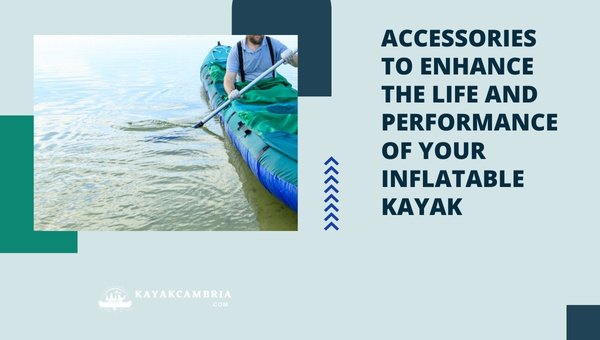
Investing in a few key accessories can significantly improve the life and performance of your inflatable kayak. These add-ons not only provide extra protection but also enhance your overall kayaking experience. Let’s explore some of these accessories and their benefits.
1. Paddle Leash
A paddle leash is an essential item that secures your paddle to your kayak, ensuring you won’t lose it while on the water. Paddle leashes come in various lengths and styles, including coiled and straight options. Having a paddle leash gives you peace of mind and frees you up to focus on fishing, wildlife watching, or simply enjoying your surroundings.
2. Inflatable Kayak Cart
An inflatable kayak cart helps you easily transport your inflated kayak to and from the water, reducing strain on the kayak and avoiding unnecessary abrasion or potential puncture damage. These lightweight carts conveniently fold or dismantle for storage and transport, making your kayaking experience less of a hassle and more enjoyable.
3. Protective Spray
While many inflatable kayaks come with UV-resistant materials, an additional layer of protection is always beneficial. UV protective spray can be applied to your kayak to prevent harmful UV rays from causing discoloration and material degradation. This accessory is especially helpful if your kayak is frequently exposed to the sun for extended periods.
4. Air Pump with Pressure Gauge
Properly inflating your kayak plays a crucial role in its longevity. Over-inflating or under-inflating your inflatable kayak can lead to performance issues and even potential damage. To avoid this, invest in an air pump with an accurate pressure gauge that can help you inflate your kayak to the recommended pressure level (usually measured in PSI).
5. High-Quality Carry Bag
A high-quality carry bag designed specifically for inflatable kayaks helps protect your investment during storage and transport. These bags often feature padded compartments and extra storage pockets for your equipment and accessories. A good carry bag should be made of durable, puncture-resistant material and have reinforced handles or straps.
By investing in these accessories, you can optimize the performance of your inflatable kayak and extend its lifespan, allowing you to enjoy many memorable adventures on the water.
Safeguarding Your Investment: Proper Usage And Kayaking Etiquette
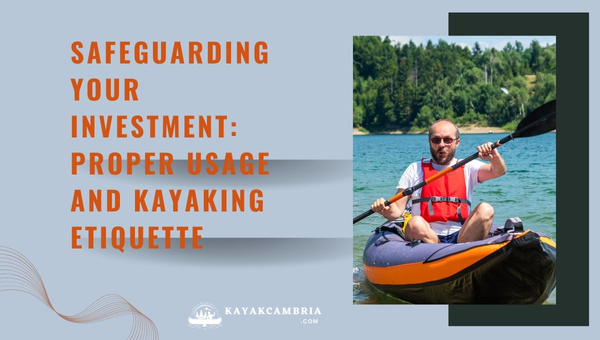
Your inflatable kayak is an investment that you want to last for many enjoyable outings, making it essential to learn proper usage techniques and observe good kayaking etiquette. Here’s how you can help protect and extend the life of your inflatable kayak.
Steer Clear of Sharp Objects and Hazards in the Water
Inflatable kayaks, while puncture-resistant, can still be damaged when coming into contact with sharp objects or hazards like rocks, submerged logs, and debris. Be vigilant while kayaking and steer clear of such obstacles to avoid potential punctures and tears.
Avoid Dragging the Inflatable Kayak Over Rough Surfaces
Dragging your inflatable kayak across rough surfaces like rocks or concrete can cause abrasions, greatly increasing the risk of tears and punctures. Instead, consider using a kayak cart or carrying the kayak with a partner to safely transport it to and from the water.
Observing Weight Limits and Proper Distribution within the Kayak
Every inflatable kayak comes with a specified weight limit, which should be respected to maintain the kayak’s structural integrity and performance. Also, make sure you evenly distribute weight throughout the kayak to prevent excessive pressure on certain areas, potentially causing damage.
Respecting the Environment and Minimizing Impact on Wildlife
Good kayaking etiquette involves being respectful of the environment and the ecosystems in which you kayak. Avoid disturbing birds and other wildlife, stay clear of nesting areas, do not throw trash in the water, and make sure your gear is free of invasive species that might be introduced into a new body of water.
Practice Safe Boating and Be Courteous to Fellow Kayakers
As a responsible kayaker, always be aware of other boats, kayakers, and swimmers around you, adhering to local boating rules and guidelines. Share launching and landing spots by being quick and efficient, and yield to other paddlers when necessary. Lastly, be prepared for emergencies by carrying a first aid kit, personal flotation device, and other necessary safety gear.
By mastering proper usage techniques and adhering to kayaking etiquette, you can actively safeguard your investment, ensuring your inflatable kayak is ready for countless waterborne adventures.
Taking Care Of Common Puncture Repair Needs
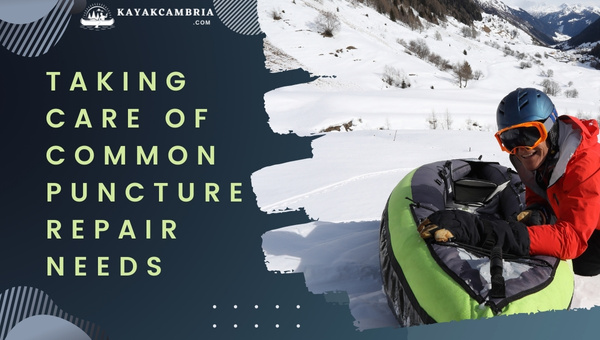
Taking care of common puncture repair needs is an important skill for every inflatable kayak owner. It’s essential to be prepared for such situations, as even the highest quality kayaks are not entirely immune to punctures. In this section, we will discuss how to manage these minor setbacks and maintain the durability of your kayak.
Identifying the Source of Punctures and Leaks
Before you can repair a puncture, you must identify its location. One simple technique involves filling the kayak with air and then applying a solution of water and mild liquid soap to its surface. Bubbles will form at the site of the leak. Another method includes listening for escaping air or feeling around the seams and hull with your hands.
Steps to Repairing a Puncture on Your Inflatable Kayak
Once the puncture or leak has been identified, follow these steps for a successful repair:
- Deflate the kayak. Make sure it is almost completely flat before proceeding.
- Clean the affected area. Use rubbing alcohol or a similar cleaning solution to thoroughly clean the puncture site, ensuring a strong bond with the repair material.
- Cut a patch. Choose a patch material suitable for your kayak (e.g., PVC, Hypalon, Nitrylon) and cut the patch (at least 1 inch larger than the puncture) in a circular or oval shape to prevent the corners from peeling.
- Apply the adhesive. Depending on the type of the material, you may need to use a specific adhesive. Applying adhesive both to the puncture site and the patch, then let it sit until it becomes tacky (check the instructions on the adhesive for the appropriate wait time).
- Attach the patch. Press and adhere the patch firmly to the puncture site, starting from the center and working your way outward. Use a roller or the back of a spoon to smooth out the patch and remove air bubbles.
- Allow ample curing time. Before re-inflating the kayak and hitting the water, allow the adhesive to fully cure. The curing time can range from a few hours to a full day, depending on the adhesive.
Puncture Repair Kits and Their Contents
It’s wise to keep a puncture repair kit on hand, which typically contains:
- Adhesive
- Patches (specific to your kayak’s material)
- Sandpaper or abrasive pad for surface preparation
- Application brush, if needed
- Detailed instructions for your specific kayak
Emergency Field Repairs for Unexpected Punctures While Out on the Water
Sometimes, punctures occur when you’re out enjoying your adventure, and a temporary fix is needed. Duct tape can be an easy short-term solution, but it should only be used as a temporary measure. Once you return to land, take the proper steps to repair the puncture as described above, ensuring your inflatable kayak remains in top condition.
The True Test Of Time: Real-Life Testimonies Of Inflatable Kayak Durability
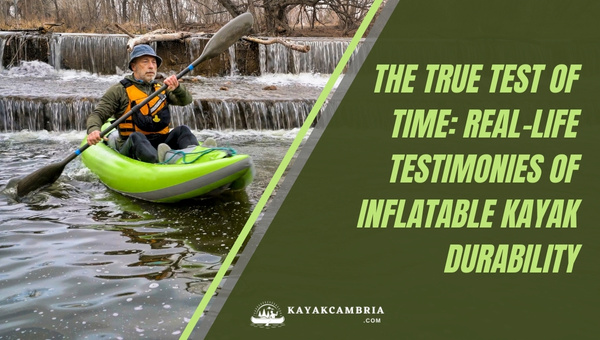
While researching and reading reviews on inflatable kayaks can provide valuable insight, there’s no better way to gauge durability than through real-life experiences from fellow kayakers. Here, I have gathered some testimonies that showcase the long-lasting nature of inflatable kayaks and the factors that contribute to their durability.
Long-lasting Love: A Whitewater Kayaker’s Best Companion
John, a passionate whitewater kayaker, shared his experience with his trusty inflatable kayak that has been with him for over six years. Despite the rough conditions and challenging obstacles typically encountered in whitewater kayaking, John’s kayak has survived numerous trips with only minor repairs for punctures and abrasions. He credits the kayak’s reinforced PVC material and quality construction for contributing to its durability.
Flatwater Fishing Escapades: Going Strong for Eight Years
Sarah, an avid angler, has been using her inflatable kayak for weekend fishing trips on calm, flat waters for nearly eight years. She praises the heavy-duty fabric and rugged seams in her kayak, which have safeguarded it from cuts and punctures. Additionally, Sarah’s consistent maintenance efforts, such as cleaning and proper storage, have played a significant role in extending her kayak’s life.
Intrepid Inflatable Expeditions: A Decade of Ocean Exploration
Steven, an outdoor enthusiast who enjoys exploring coastal areas and open waters, proudly shared that his inflatable kayak has been his trusty companion for over ten years. While using it in ocean environments, he has been impressed by the kayak’s resistance to damage from saltwater, sunlight, and marine debris. Steven attributes his inflatable kayak’s long-lasting nature to the excellent build quality, the use of premium Hypalon fabric, and, again, his own regular maintenance routine.
These testimonies prove that with proper care, maintenance, and responsible usage, you can have an inflatable kayak that truly stands the test of time. Investing in a high-quality product from a reputable brand, understanding your intended usage, and adhering to proper kayaking etiquette can help ensure that your inflatable kayak will be a reliable and durable companion throughout your adventures on the water.
Frequently Asked Questions
1. How much weight can my inflatable kayak support?
It all depends on the specific model and its defined weight capacity. In general, single-person inflatable kayaks can support between 250-350 lbs, while tandem models usually have capacities between 400-600 lbs. It’s essential to check the manufacturer’s specifications for your inflatable kayak and not exceed the weight limit to avoid compromising its durability and performance.
2. How well do inflatable kayaks fare against punctures and abrasion?
Inflatable kayaks, particularly those made from high-quality and puncture-resistant materials like Hypalon or Nitrylon, offer impressive resistance to punctures and abrasion. While it’s essential to be careful and avoid sharp objects, these kayaks can withstand occasional encounters with rocks, branches, and other obstacles without getting punctured.
3. Can I use my inflatable kayak for whitewater kayaking?
Some inflatable kayaks are specifically designed for whitewater kayaking and are built to handle the challenges of rapids and rough waters. It’s crucial to ensure the kayak you plan to use is rated for the type of whitewater you’re attempting. Check for features like self-bailing, rocker profiles, and reinforced material construction that makes a kayak suitable for tackling whitewater conditions.
4. Is it okay to leave my inflatable kayak inflated between uses?
While it can be tempting to leave your kayak inflated for convenience, doing so can lead to overexposure to sunlight and possible over-inflation due to heat. It’s advisable to deflate your kayak when not in use, clean it thoroughly, and store it in a cool, dry environment. This practice will help prolong the lifespan and maintain the structural integrity of your inflatable kayak.
5. How long does it take to inflate and set up an inflatable kayak?
The inflation and setup time for inflatable kayaks vary depending on the model and type of pump used. With an efficient manual pump, most inflatable kayaks can be inflated within 5-15 minutes. Using an electric pump could further reduce the inflation time. Be sure to follow the manufacturer’s guidelines regarding the right pressure for your inflatable kayak and use a pressure gauge to ensure proper inflation.
6. Can I use my inflatable kayak for fishing?
Absolutely! Many inflatable kayaks are designed specifically for fishing adventures with features like rod holders, storage compartments, and mountable accessories. However, even if you have an all-purpose inflatable kayak, you can still enjoy a fishing trip as long as your kayak has the weight capacity for you and your gear, and you take care to avoid hook punctures. Be mindful of your surroundings and avoid sharp objects in the water to protect your investment.
Conclusion
The lifespan of an inflatable kayak varies greatly depending on the material, quality of construction, frequency of usage, and the level of care and maintenance provided by the owner. With proper care and best practices, your inflatable kayak can last for many years, providing you with countless adventures and memories.
By taking the time to understand the factors that impact the longevity of your inflatable kayak, investing in a product made from high-quality materials, diligently following routine maintenance, and addressing repairs promptly, you can maximize the life of your kayak and even extend it beyond the manufacturer’s warranty period. Furthermore, respecting kayaking etiquette and the environment not only benefits the lifespan of your kayak but also helps preserve our treasured waterways for future generations to enjoy.
Remember, when it comes to inflatable kayaks, you often get what you pay for. By prioritizing quality, durability, and proper care and maintenance, you can rest assured that your investment will provide you with many memorable experiences on the water, leaving you free to focus on what’s most important – enjoying the ride!

